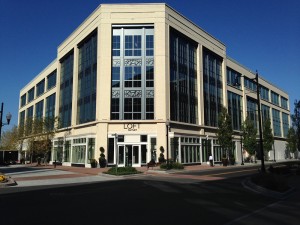Somerville, MA According to Federal Realty Investment Trust, its office building at 450 Artisan Way in the Assembly Row district has achieved LEED Gold status, the first office building to ever achieve that status in Somerville. Cranshaw Construction was the general contractor for the project, Kling Stubbins and Street-Works Studio were the architects.
450 Artisan Way, a 100,000 s/f office building that is part of the completed first phase of the Assembly Row development, was awarded a LEED Gold certificate by the U.S. Green Building Council (USGBC). LEED is the nation’s preeminent program for certifying environmentally efficient design, construction and operation practices for buildings.
“Assembly Row highlights some of the very best sustainability practices of new developments - high-density, mixed-use, transit-oriented and focused on bettering the community and enhancing the quality of life for residents, employees and visitors,” said Chris Brown, sustainability director at Federal Realty. “450 Artisan Way builds upon those core sustainable attributes to provide a better workplace environment.”
The 450 Artisan Way office building achieved LEED Gold Core & Shell Development certification by incorporating sustainable construction techniques that include:
• Roofing integrated both with a landscaped area and white EPDM (Ethylene Propylene Diene Monomer) roofing, which reduces “heat island effect” (built up areas that are hotter than nearby areas). The roof was installed by a local Somerville company, ReCover Green Roofs, which cut down on worker’s travel and supported local business.
• Optimizing the exterior façade design by providing increased insulation and high performance glazing, balancing access to daylight and exterior views with energy performance. The building has achieved energy savings 16% above the LEED baseline and meets the Somerville Stretch Energy Code.
• Using recycled and regionally sourced materials including certified wood used when possible to build the office building.
• Providing bicyclists with easy access to the building by providing an in-building, secure bike room and an adjacent shower and changing area.
• Using “Green power” that is generated from offsite renewable energy sources.
Responsibly built office buildings have been widely reported to increase productivity and access to natural light can help energize the building’s occupants to support a happier work environment – an important, and measured, quality of life metric.
“Providing the most efficient, productive and enjoyable work space for employees is a top priority for SmartBear,” said Doug McNary, CEO of SmartBear. “Since moving into our new corporate headquarters earlier this year at 450 Artisan Way at Assembly Row, we have enjoyed convenient commuting options, including public transit, an open office environment with access to natural sunlight that inspires collaboration, as well as numerous amenities within blocks that have positively impacted the lifestyles of our employees and clients. We believe that the many benefits we enjoy within our office space and the surrounding area, all while using less energy and reducing our carbon footprint, is one of the reasons we attract some of the area’s best talent in technology.”
Originally a brownfield site, Assembly Row is an excellent model of responsible design and planning. Several of the Assembly Row retailers have also been recognized for their sustainable retail build outs, achieving LEED Gold. Nike, also on ArtisanWay, achieved a LEED Platinum certification.
“We often focus on the transit, economic, and job or housing creation benefits of Assembly Row, but it is important to remember that new development done with an eye toward sustainability can benefit our city in so many other ways from the new green space or transit access it can bring to energy efficient buildings,” said Somerville mayor Joseph Curtatone. “I want to commend Federal Realty for helping the City reach this important milestone in building our first LEED Gold certified office building and, in doing so, for setting a new standard.”
Those in the Assembly Row neighborhood realize the benefits of sustainable development on a daily basis:
• Federal Realty’s improvements to the district’s storm water system are helping to reduce the level of pollution flowing into the river from Somerville’s main line.
• Access to Assembly Station, the first T station added to the Orange Line in over 25 years, which is located within two blocks of any current or future employees, encourages employees to use public transit regularly.
• Being part of the high-density, mixed-use project of Assembly Row – apartments, restaurants and entertainment are all within steps of the office lobby, transit is a short walk for employees and employees have access to over 40 shops
• Additional green space in the expanding neighborhood and Federal Realty’s commitment to work with prospective clients on responsible design to ensure the continuation of smart growth as Assembly Row supports the overall well-being of the community, inside and out.
• An active environment that builds engagement, takes advantage of green and open space, fosters collaboration through its common area design and supports resident’s well being with weekly riverside yoga, bi-weekly boot camp, weekly farmer’s market and over 170 annual events within the neighborhood.
• The merchandise mix, today and coming in Phase II, is planned to balance work, fun, and life’s needs so no employee needs to stray more than two blocks to grab lunch, bank, shop, or meet friends. This active retail street decreases the need or reliance on a car to tackle to-do lists.
“The designation from the USGBC for 450 Artisan Way and the sustainable nature of Assembly Row benefits more than just the building’s occupants,” said Don Briggs, President of Federal Realty Boston. “Businesses and taxpayers can save money; greenhouse gas emissions are reduced; and the building helps to contribute to a healthier environment for its workers and the larger community.”







